Removal Procedure
- Remove the battery box and carefully set the engine control module (ECM) on top of the engine. Refer to
Battery Box Replacement.
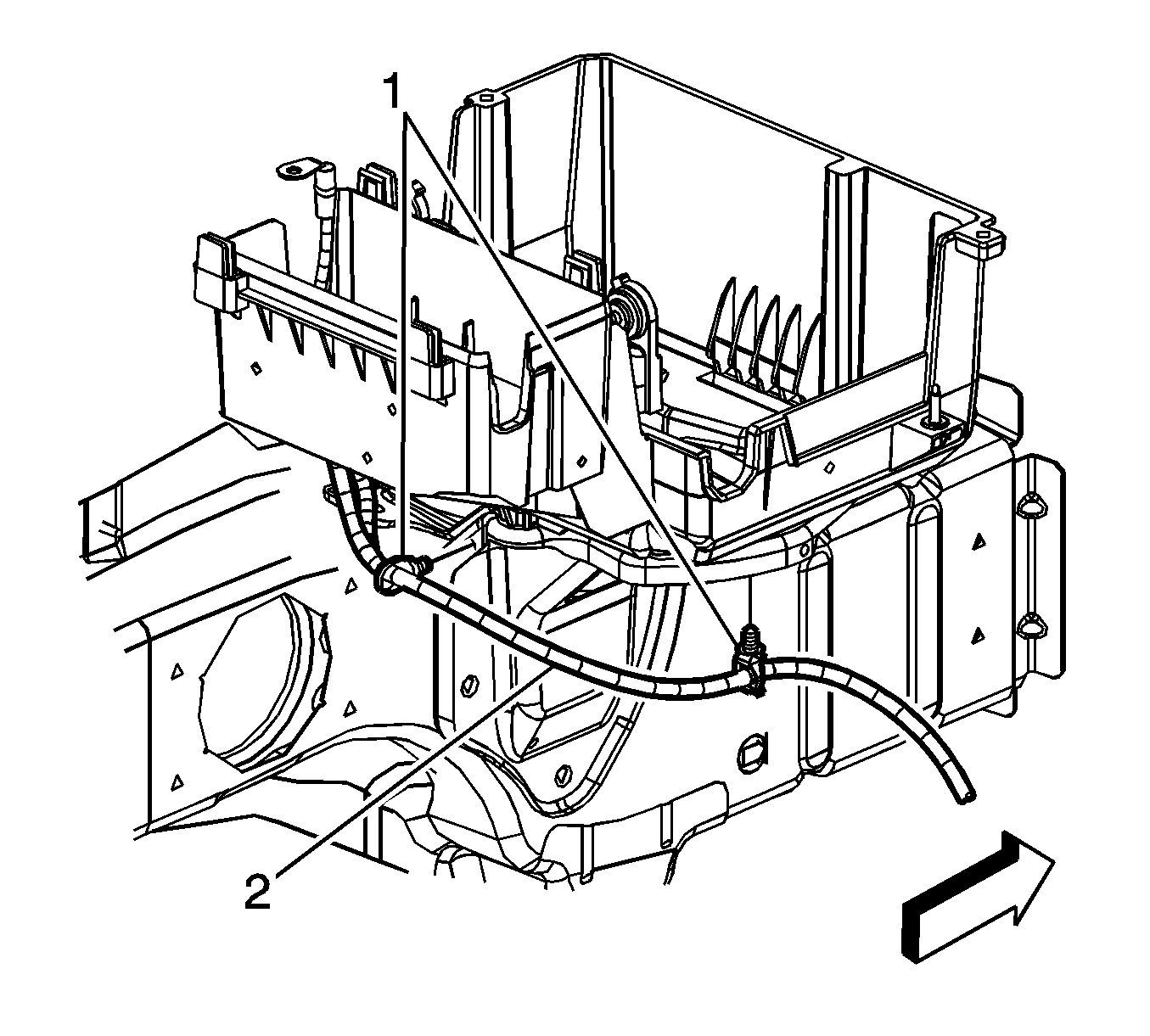
- Remove the battery cable retainers (1) from the battery tray.
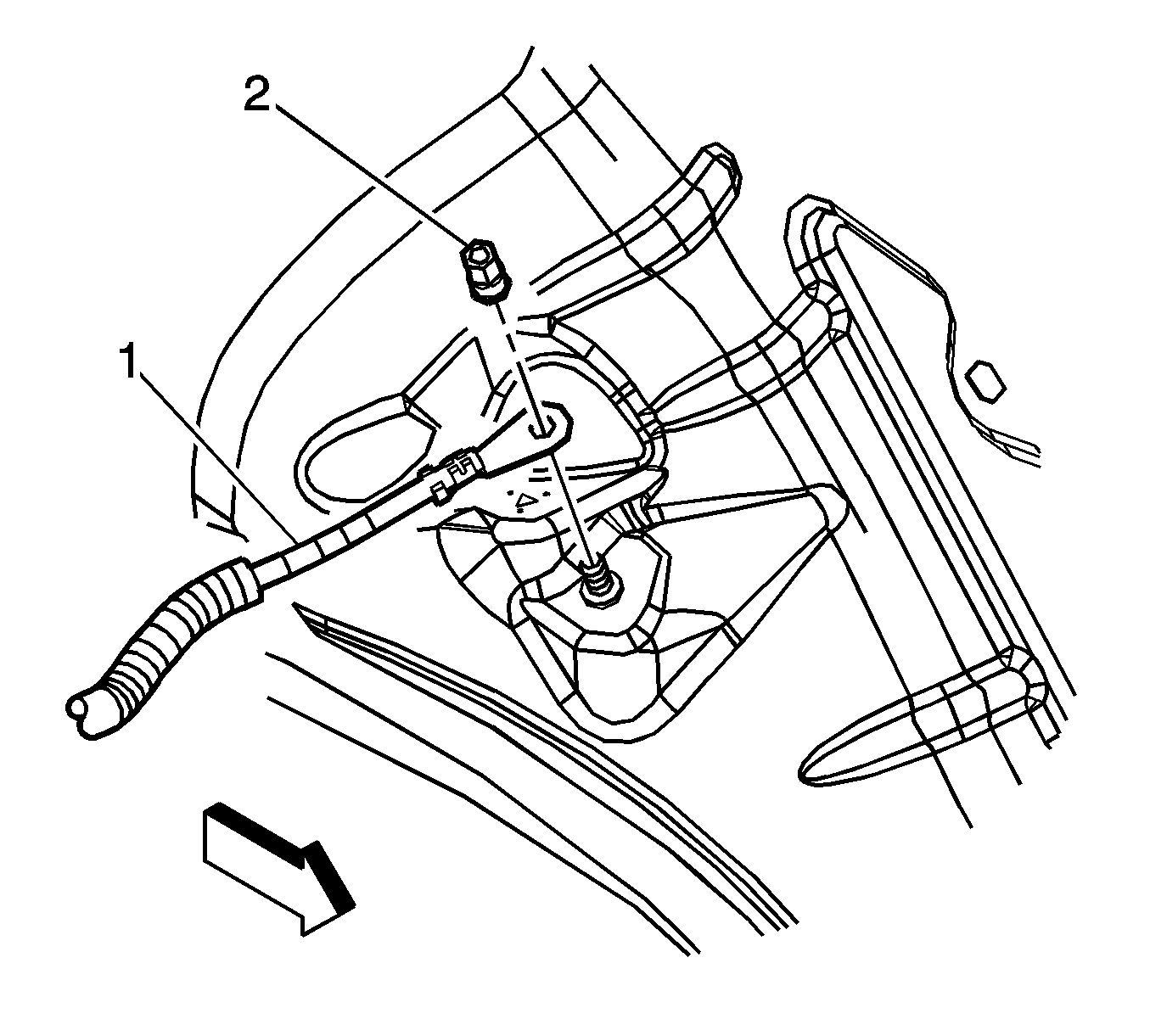
- Remove the negative battery cable nut (2) from the inner fender body ground stud.
- Remove the negative battery cable (1) from the inner fender body ground stud.
- Remove the fuel injector sight shield. Refer to
Fuel Injector Sight Shield Replacement.
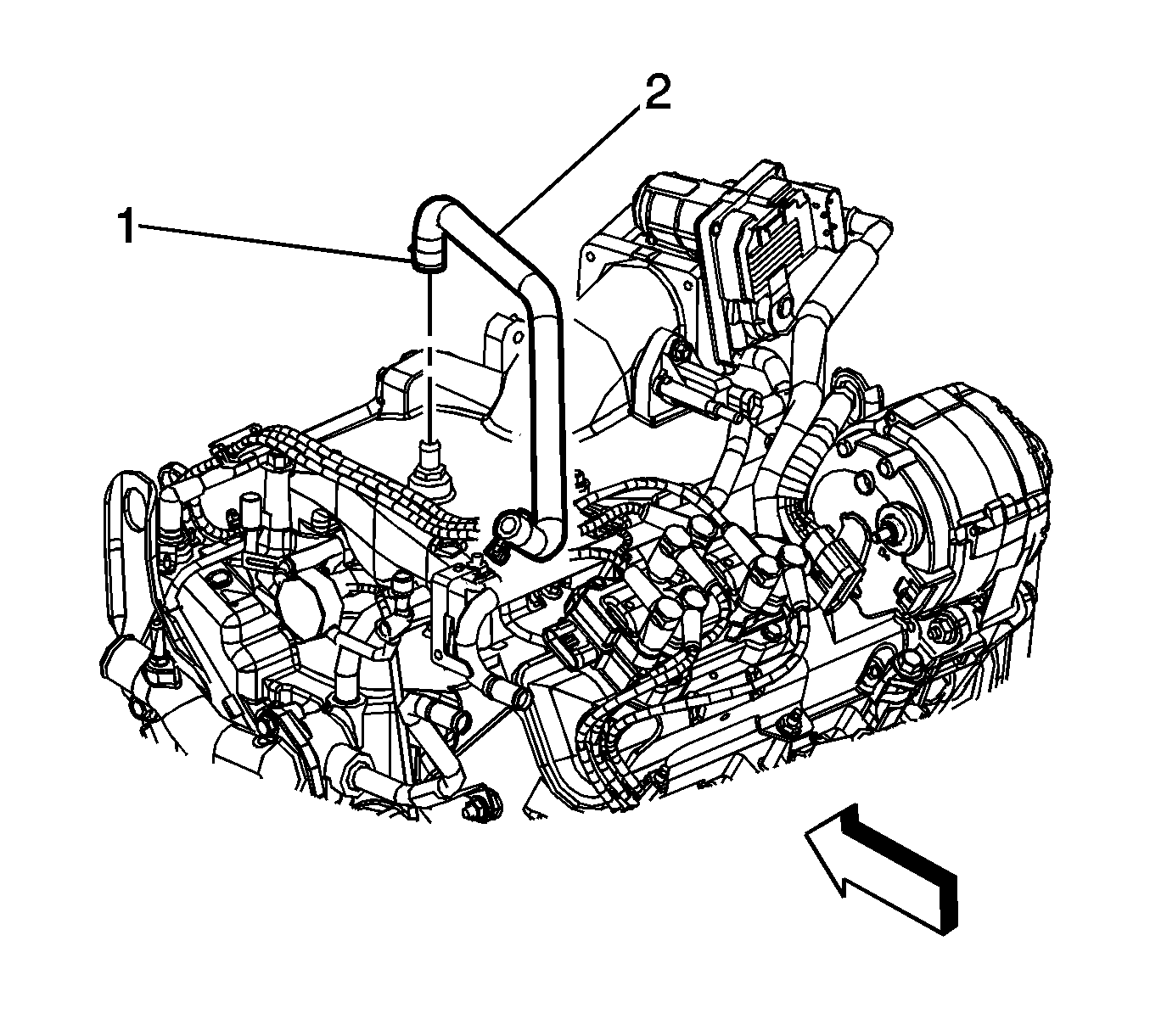
- Release the clamp (1) from the brake booster vacuum hose connection.
- Disconnect the brake booster vacuum hose (2) from the intake manifold.
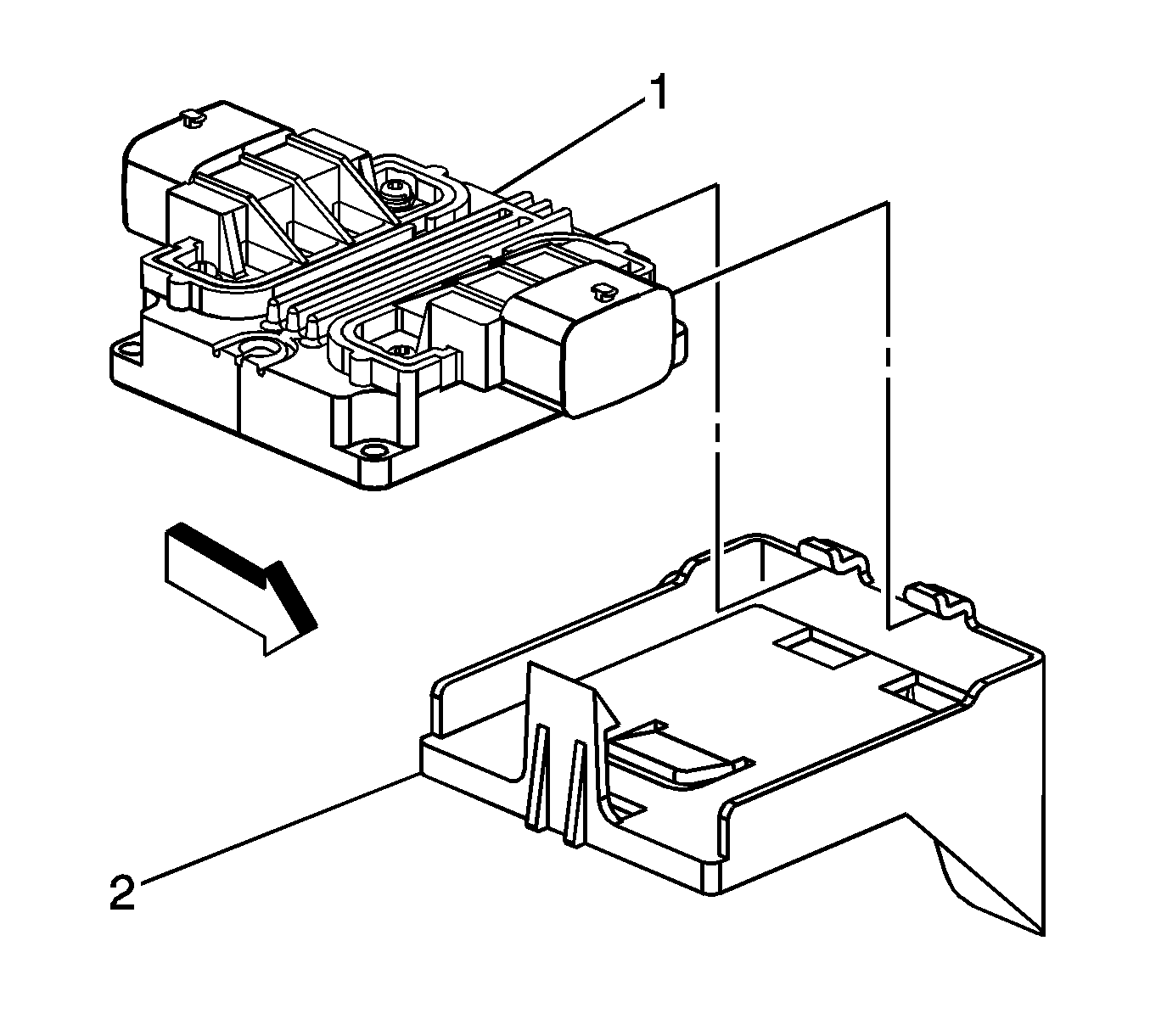
- Remove the transaxle control module (TCM) (1) from the bracket (2) and set the TCM on top of the engine.
- Remove the air cleaner assembly and air intake duct. Refer to
Air Cleaner Assembly Replacement.
- Discharge the fuel system. Refer to
Fuel Pressure Relief.
- Disconnect the evaporative emission (EVAP) hose/pipe from the EVAP canister purge solenoid valve. Refer to
Plastic Collar Quick Connect Fitting Service.
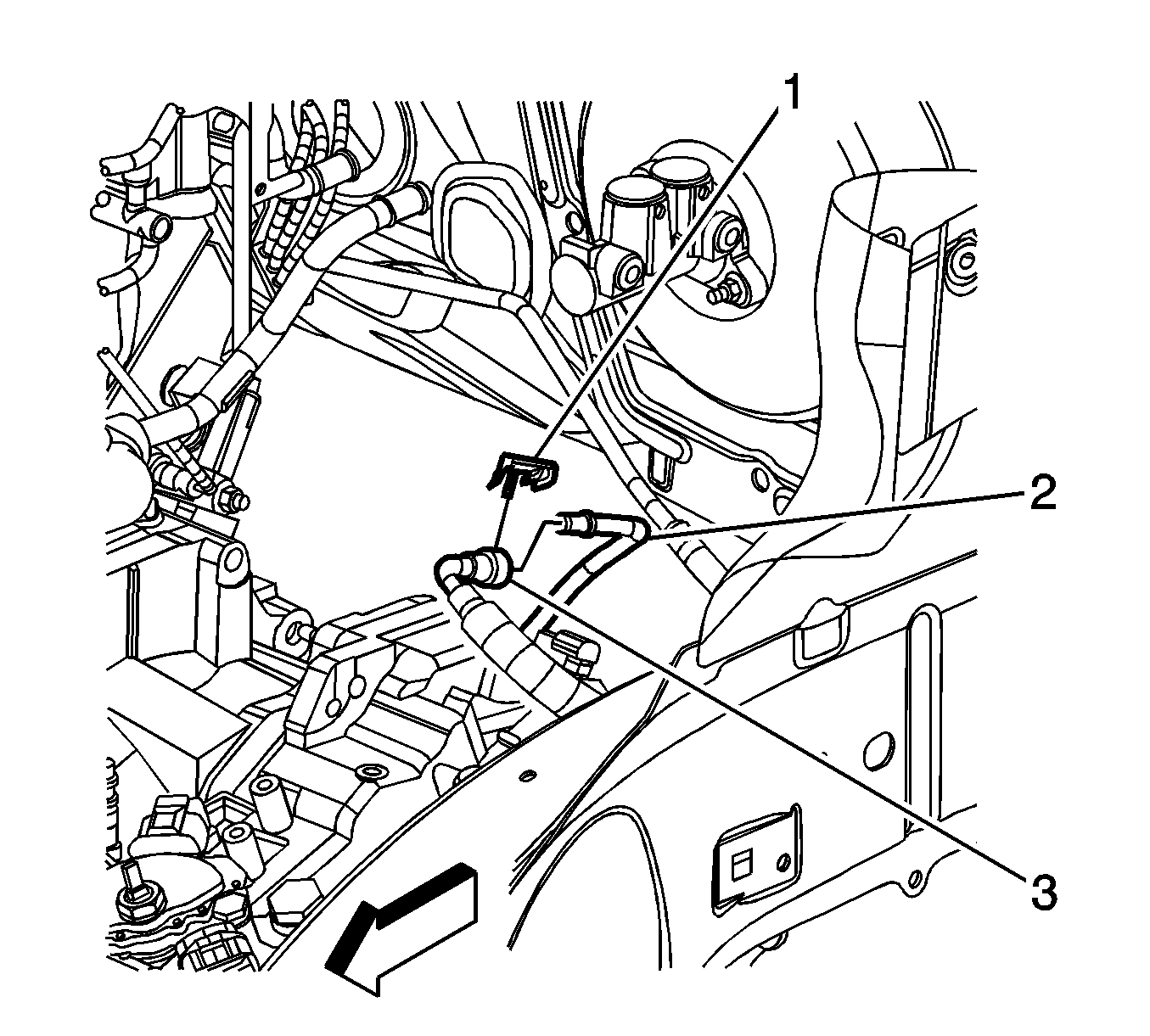
- Disconnect the engine fuel hose/pipe (3) from the chassis fuel hose/pipe (2). Refer to
Metal Collar Quick Connect Fitting Service.
- Discharge the air conditioning (A/C) system. Refer to
Refrigerant Recovery and Recharging.
- Remove the A/C compressor hose assembly from the compressor. Cap or plug the hoses and compressor to prevent contamination. Refer to
Air Conditioning Compressor Hose Replacement.
- Disconnect the transaxle shift control cable from the transaxle. Refer to
Shift Control Cable Replacement.
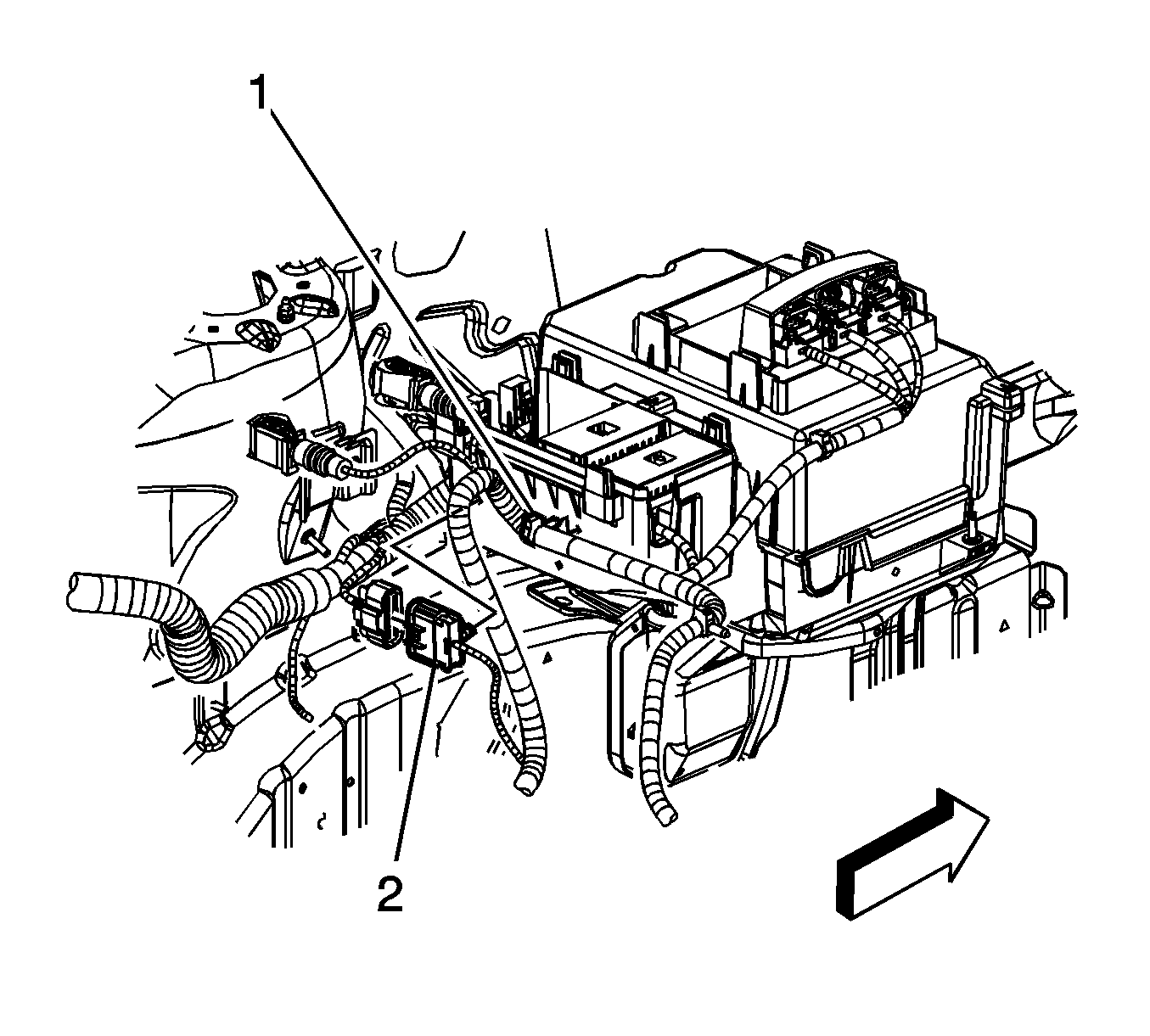
- Disconnect engine to body inline connector C102 (2).
- Drain the engine coolant from the cooling system. Refer to
Cooling System Draining and Filling.
- Tie the radiator, A/C condenser, and fan module assembly to the upper radiator support to keep the assembly with the vehicle when the frame and drivetrain is removed.
- Remove the coolant surge tank. Refer to
Radiator Surge Tank Replacement.
- Disconnect the heater hoses from the engine. Refer to
Heater Inlet Hose Replacement.
- Remove the radiator inlet hose. Refer to
Radiator Inlet Hose Replacement.
- Raise and support the vehicle. Refer to
Lifting and Jacking the Vehicle.
- Remove the radiator outlet hose. Refer to
Radiator Outlet Hose Replacement.

- Disconnect the transaxle oil cooler lines from the transaxle and remove the seals. Refer to
Transmission Fluid Cooler Pipe Seal Replacement.
- Cap the transaxle oil cooler lines and plug the transaxle oil cooler line fittings to prevent loss of transmission fluid.
- Remove the front bumper fascia air deflector. Refer to
Front Bumper Fascia Air Deflector Replacement.
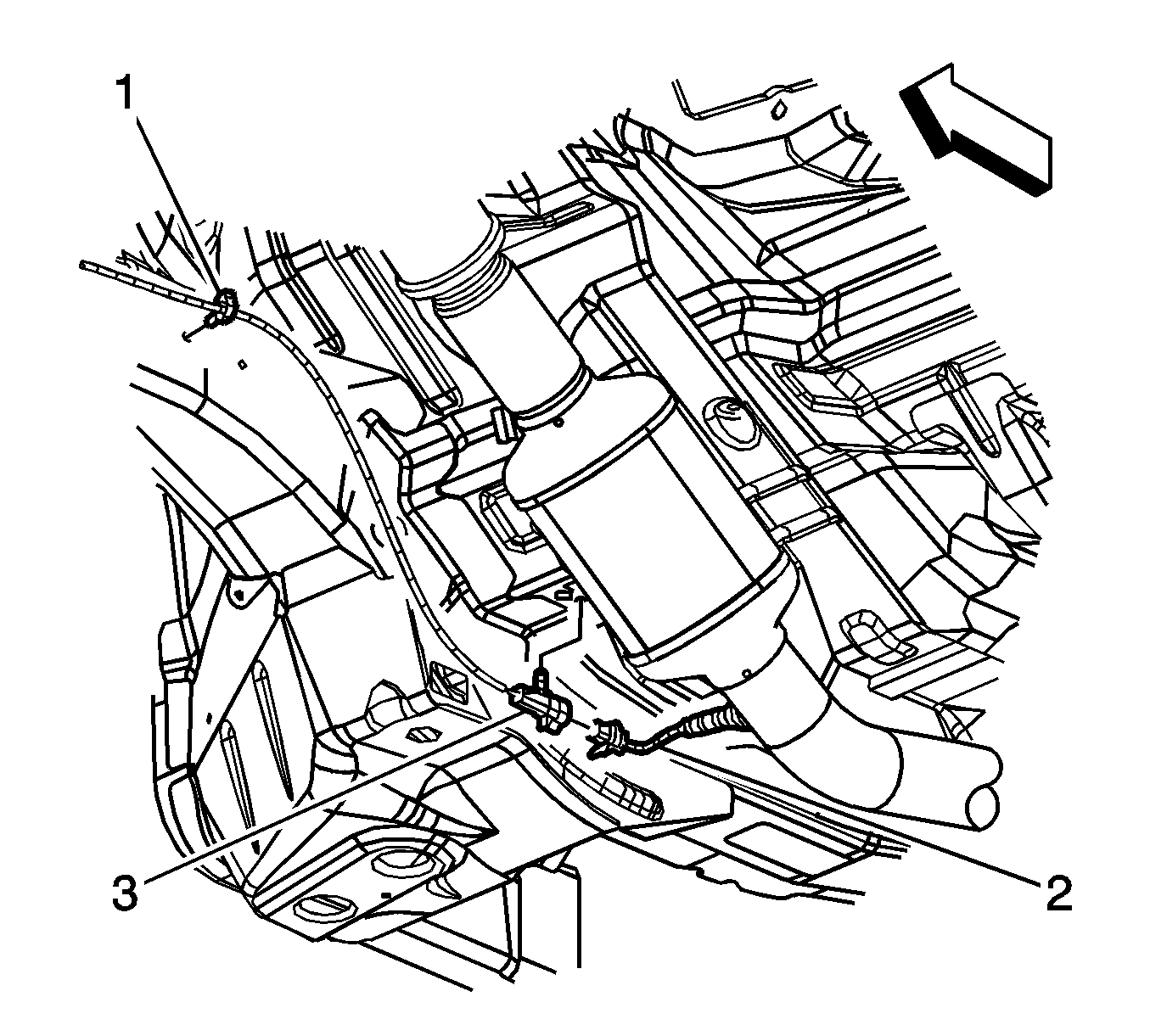
- Disconnect the heated oxygen sensor (HO2S) 2 wiring harness (2).
- Remove the HO2S 2 wiring harness retainers (1, 3) from the vehicle underbody.
- Remove the catalytic converter and secure the rear half of the exhaust system to the vehicle underbody. Refer to
Catalytic Converter Replacement.

- If equipped with all wheel drive (AWD), disconnect the transfer case vent hose from the transfer case.
- Remove the front tires. Refer to
Tire and Wheel Removal and Installation.
- Remove the right and left engine splash shields. Refer to
Engine Splash Shield Replacement.
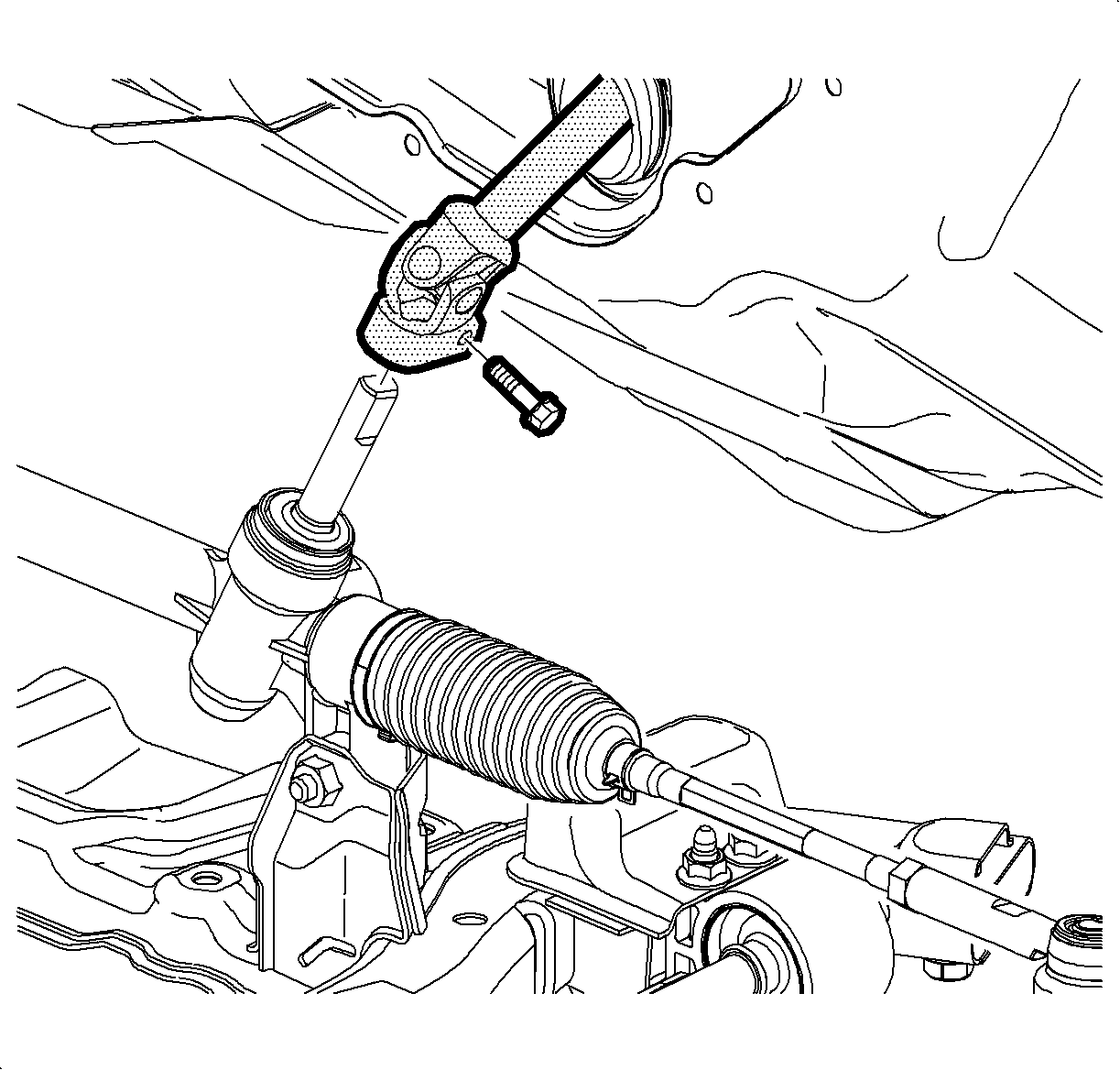
- Remove the steering intermediate shaft pinch bolt and discard the bolt.
- Disconnect the steering intermediate shaft from the steering gear.
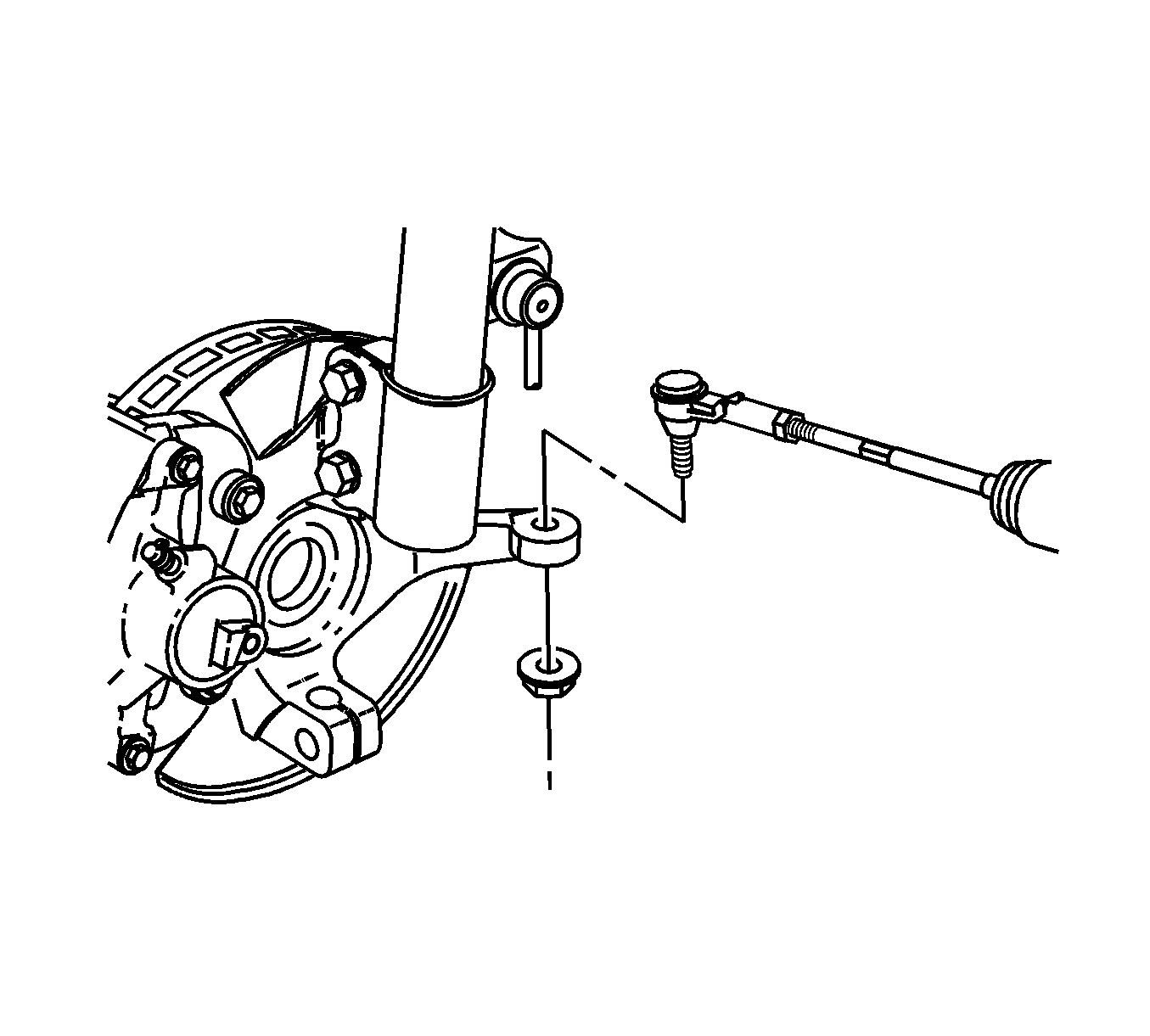
- Remove the right and left outer tie rod ends from the steering knuckles. Refer to
Steering Linkage Outer Tie Rod Replacement.
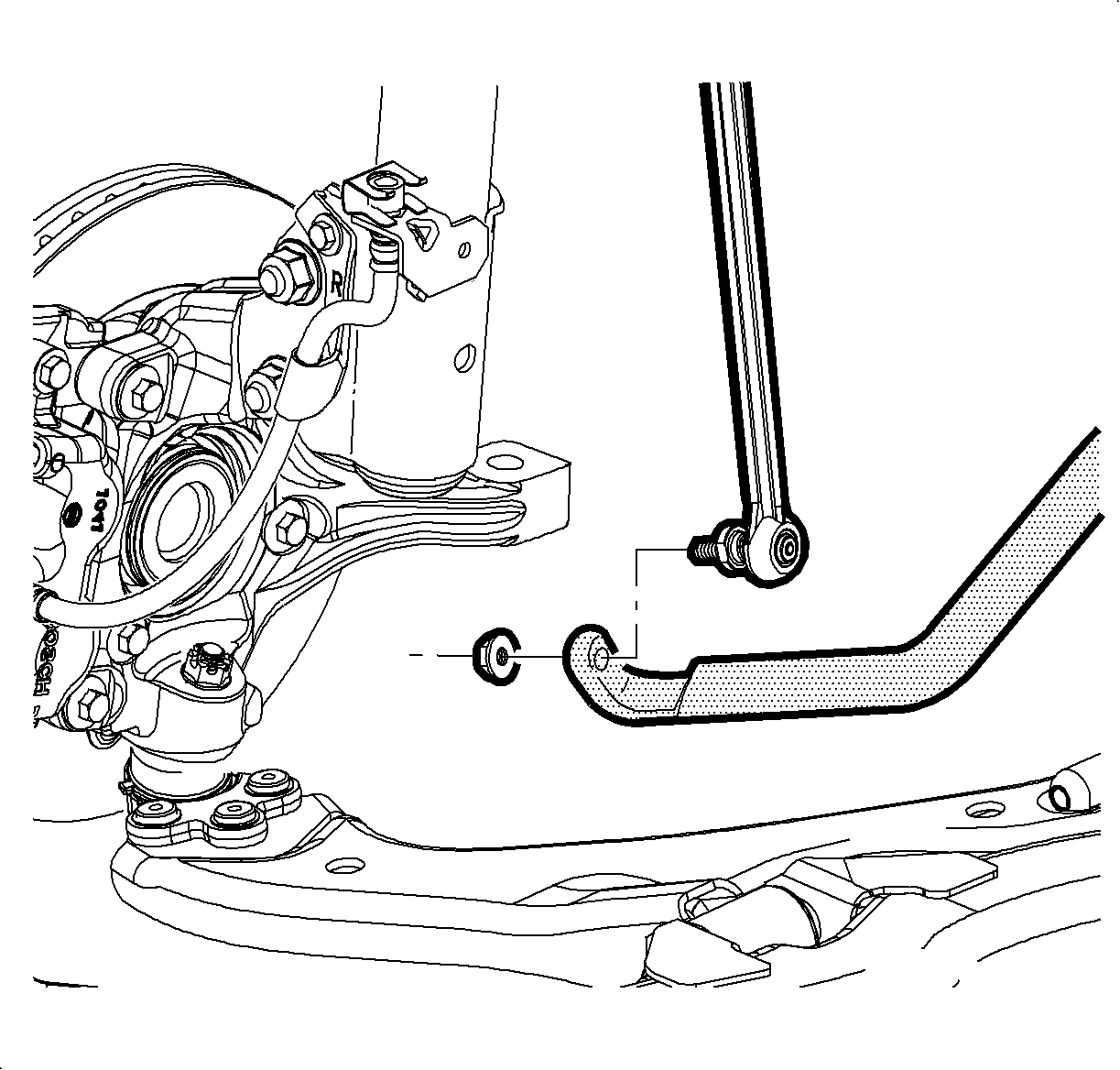
- Remove the right and left stabilizer shaft links from the stabilizer shaft. Refer to
Stabilizer Shaft Link Replacement.
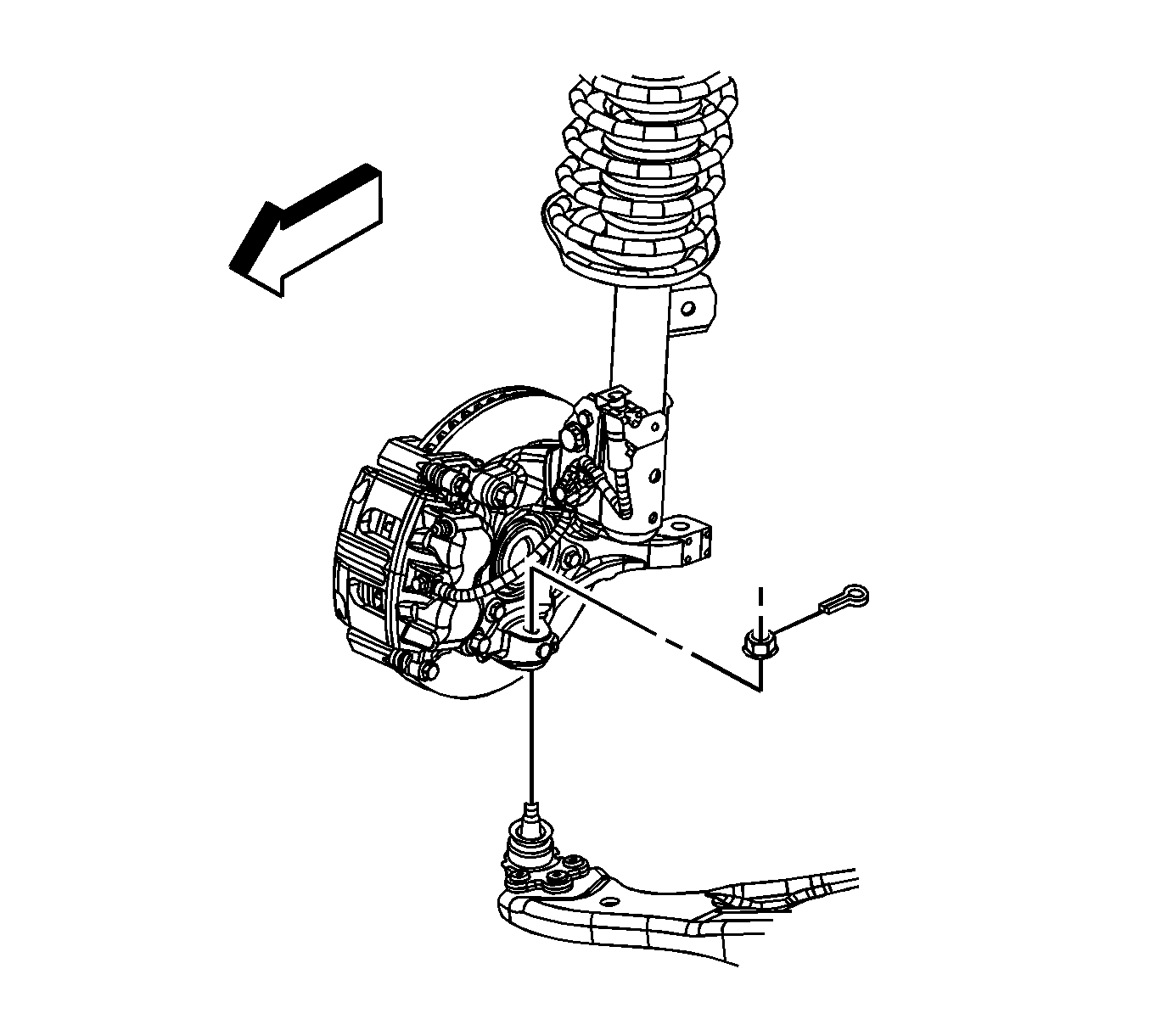
- Remove the right and left lower ball joints from the steering knuckles. Refer to
Lower Control Arm Replacement.
- Remove the right and left front wheel drive shafts. Refer to
Front Wheel Drive Shaft Replacement.
- If equipped with AWD, remove the rear propeller shaft. Refer to
Propeller Shaft Replacement.
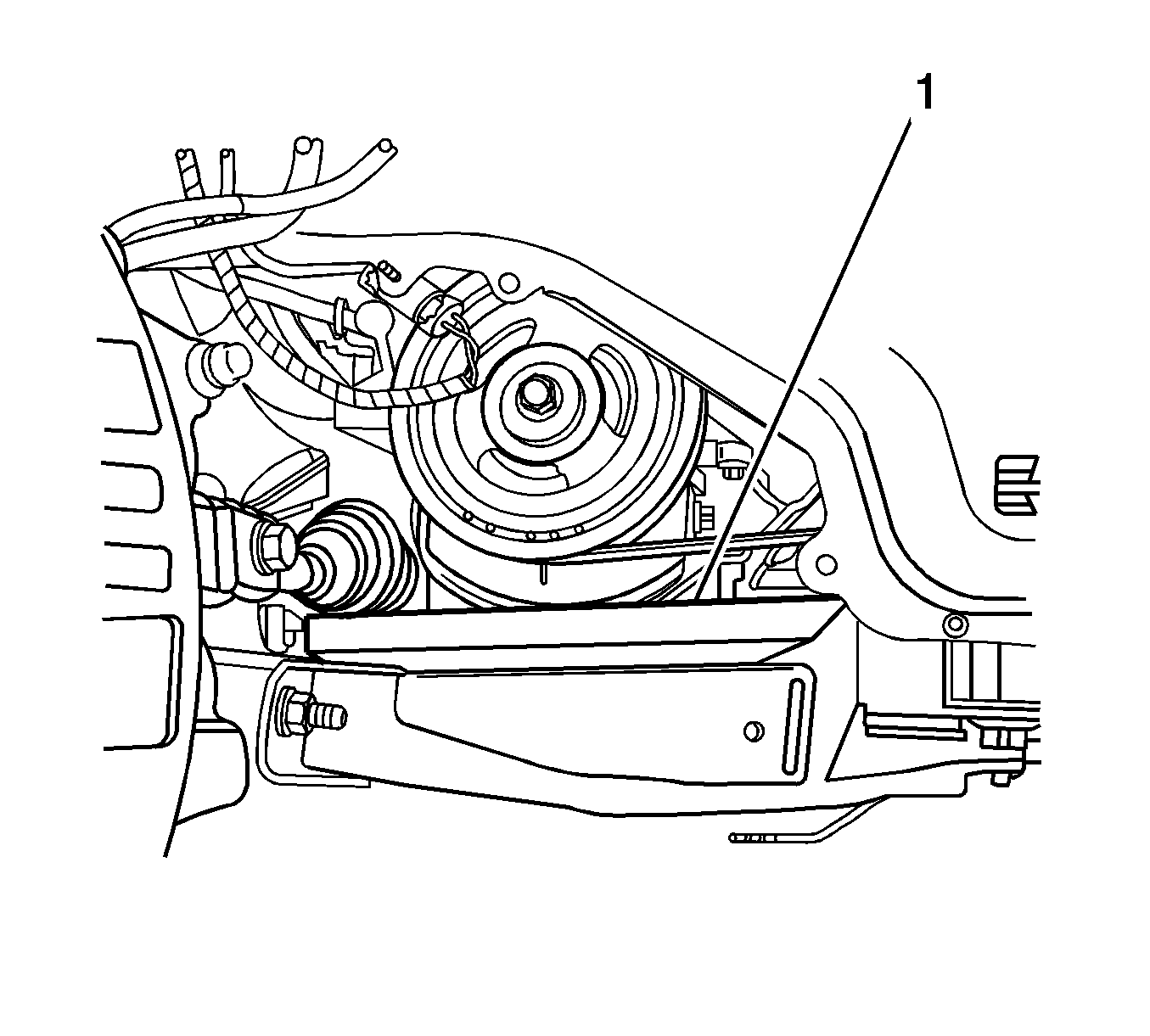
- Place a block of wood (1) between the frame and the engine oil pan in order to support the engine once
the bolts are removed from the right engine mount.
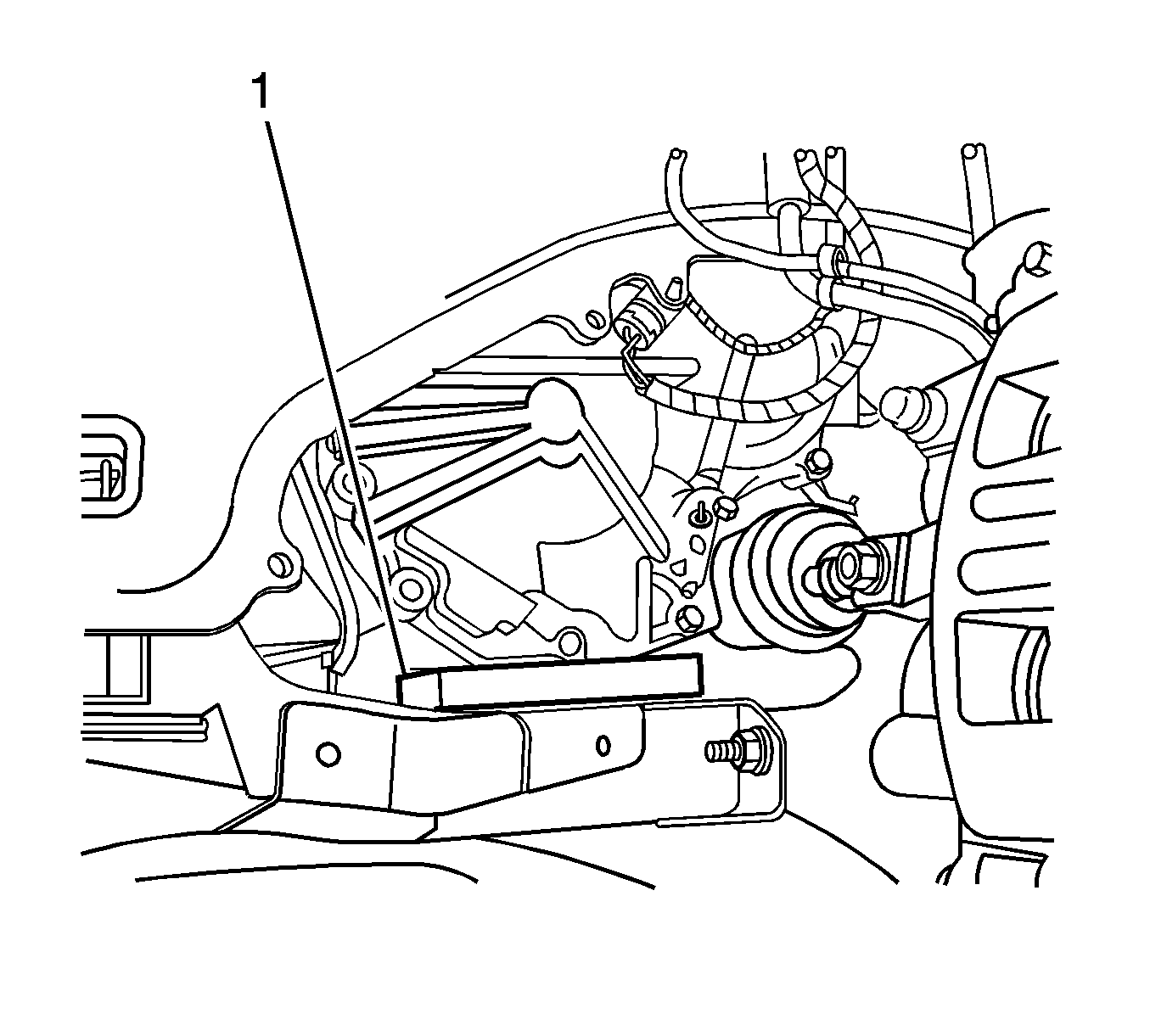
- Place a block of wood (1) between the frame and the transaxle in order
to support the transaxle once the bolts are removed from the left transaxle mount.
- Lower the vehicle.
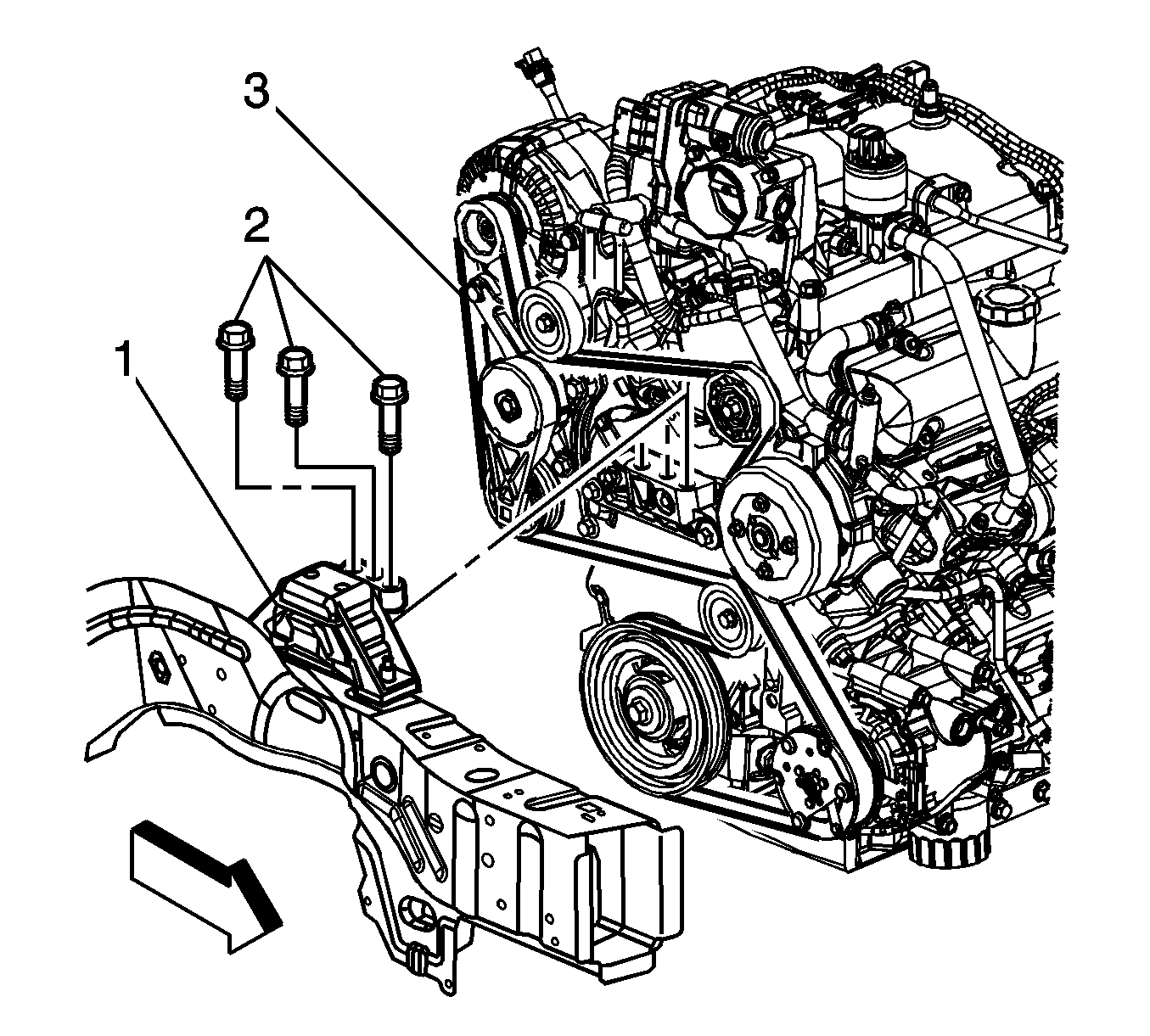
- Remove the bolts (2) that secure the right engine mount (1) to the engine (3).
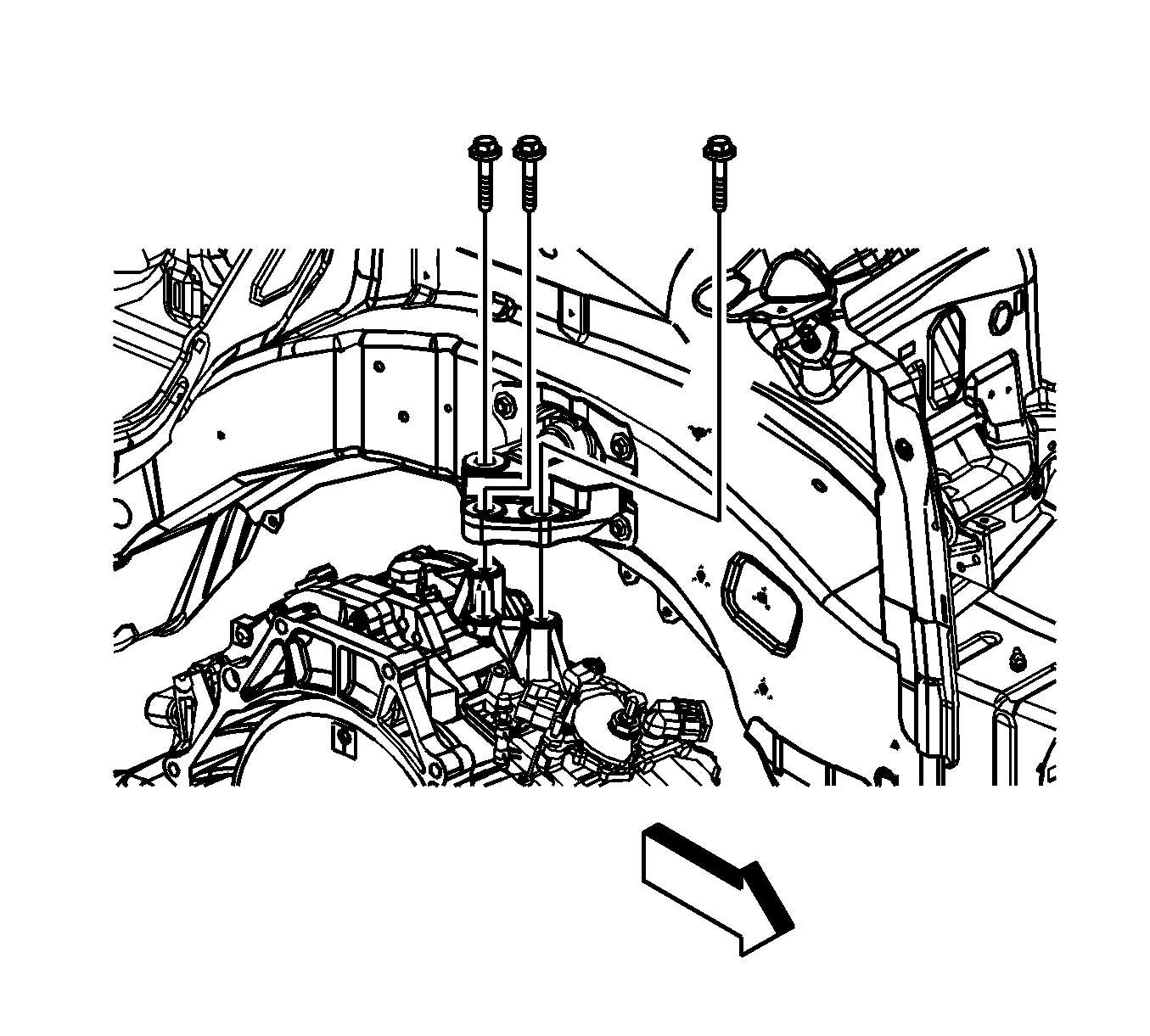
- Remove the bolts that secure the left transaxle mount to the transaxle.
Note: Ensure the vehicle body is secured to the hoist.
- Raise the vehicle.
- Place a universal frame support fixture or jackstands under the frame.
- Lower the vehicle until the frame contacts the frame support fixture or jackstands.
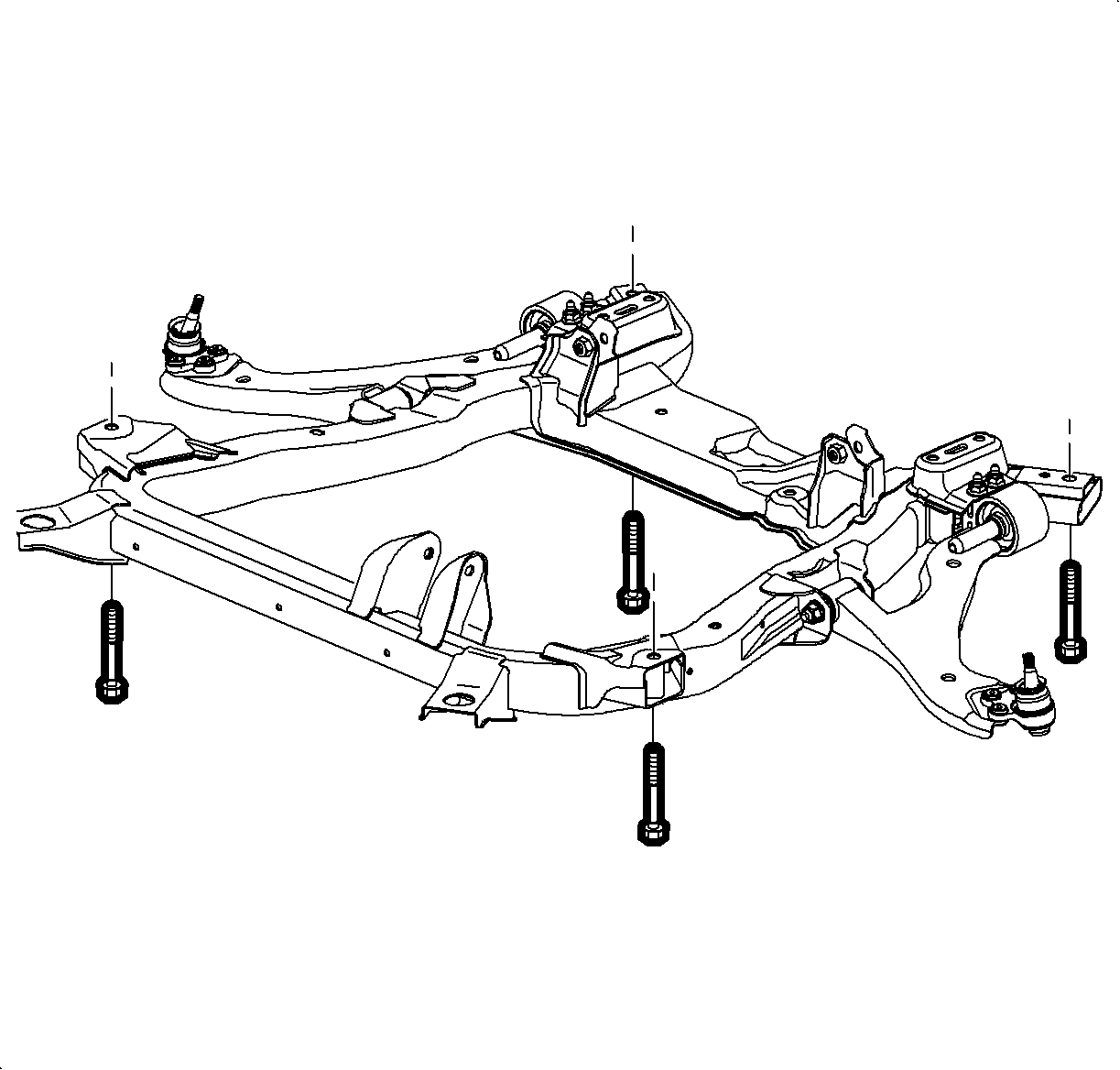
- Remove the frame-to-body bolts. Discard the bolts.
Note: Inspect for areas of body to powertrain contact or entanglement of wires and hoses while separating the vehicle body and powertrain.
- Carefully raise the vehicle body up away from the powertrain.
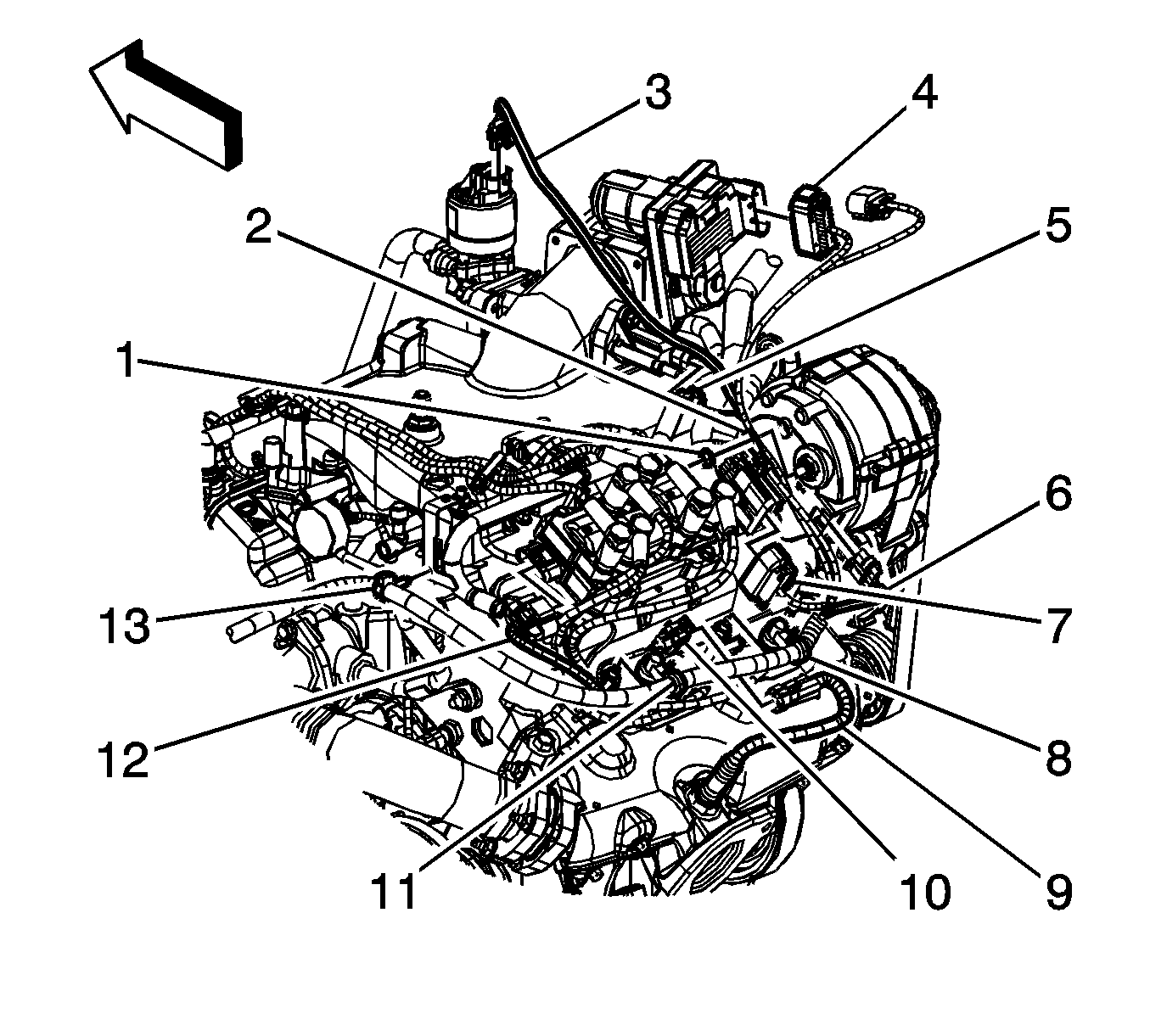
- Disconnect the engine electrical wiring harness from the following components:
| • | Exhaust gas recirculation (EGR) valve (3) |
| • | EVAP purge solenoid (5) |
| • | Remove nut (1) and generator B+ lead (2) |
| • | Generator regulator (6) |
| • | Fuel injector inline connector (7) |
| • | Heated oxygen sensor (H2OS) 1 (9, 10) |
| • | Ignition coil/control module (12) |
| • | Remove wire harness from retainers (8, 11, 13) |

- Disconnect the engine electrical wiring harness from the following components:
| • | Crankshaft position (CKP) sensor (2) |
| • | Remove bolt (4) and ground lead (3) |
| • | Remove the wire harness from retainers (5, 6) |
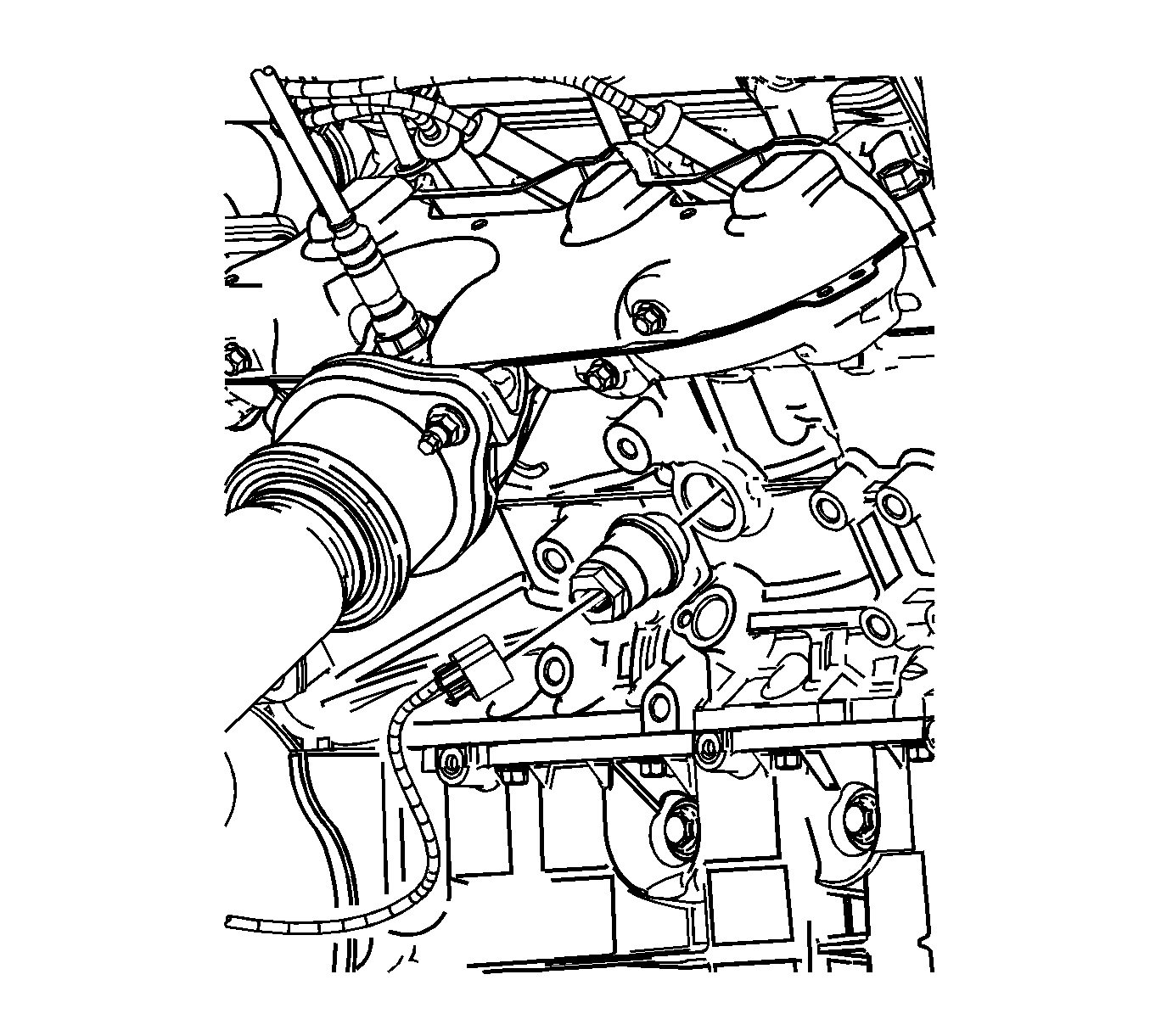
- If equipped with an engine coolant heater, disconnect the coolant heater cord.

- Disconnect the engine electrical wiring harness from the following components:
| • | Air conditioning (AC) compressor clutch (1) |
| • | AC refrigerant pressure sensor (2) |
| • | Remove wire harness from retainer (3) |
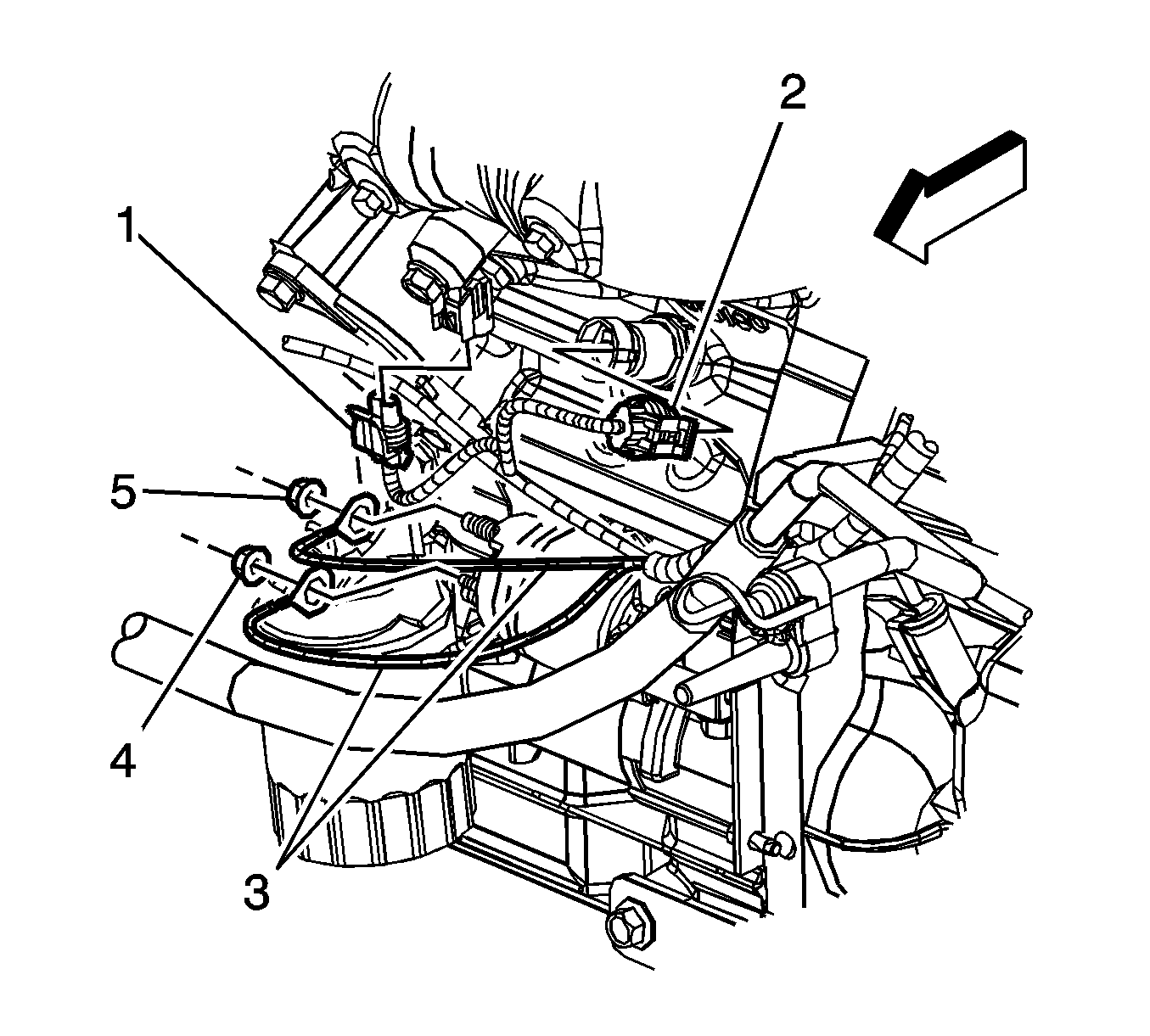
- Disconnect the engine electrical wiring harness from the following components:
| • | Oil pressure indicator switch (2) |
- Remove the throttle body assembly. Refer to
Throttle Body Assembly Replacement.
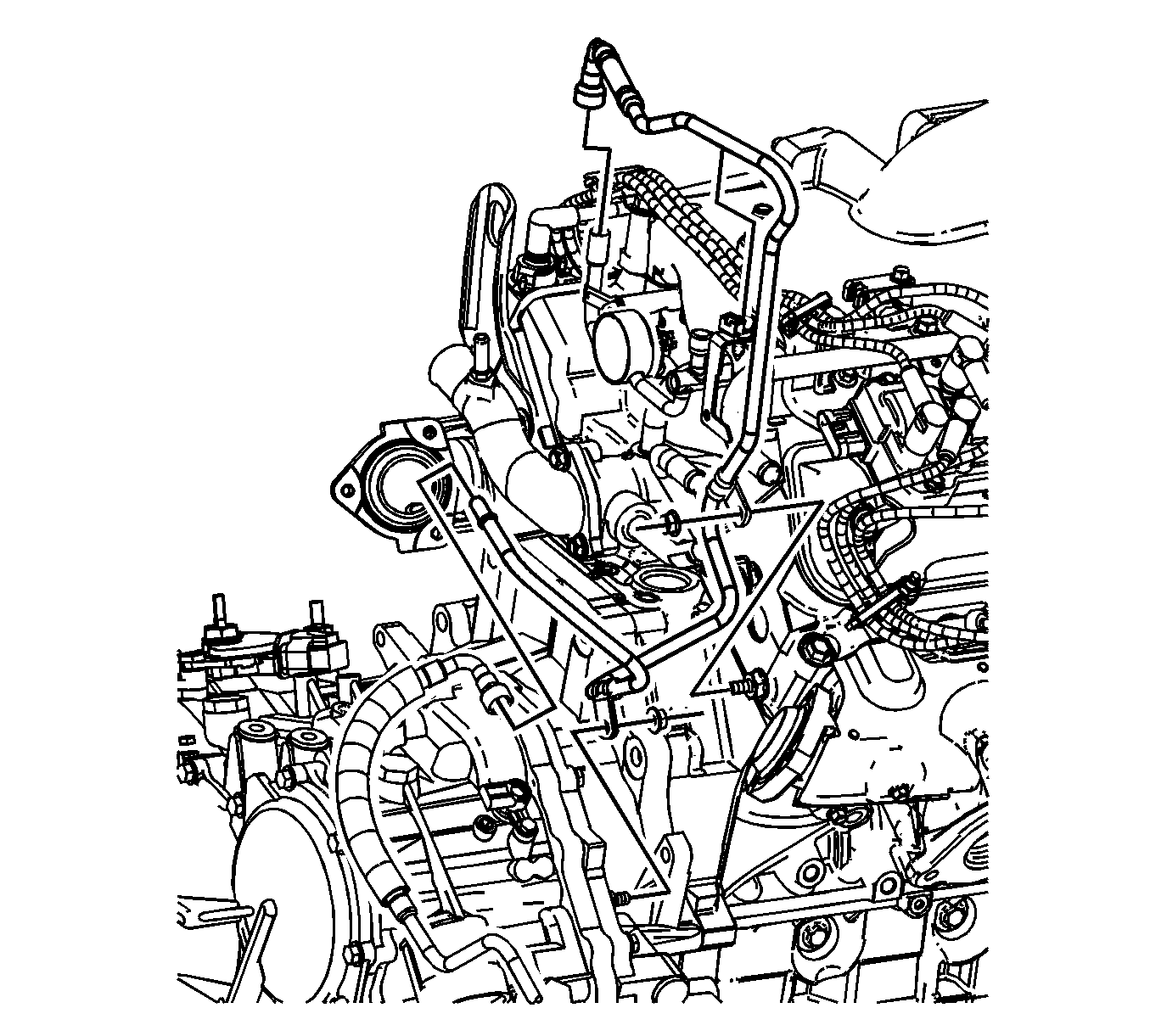
- Remove the nut securing the fuel pipe to the transaxle.
- Remove the fuel pipe retainer from the threaded stud on the transaxle.
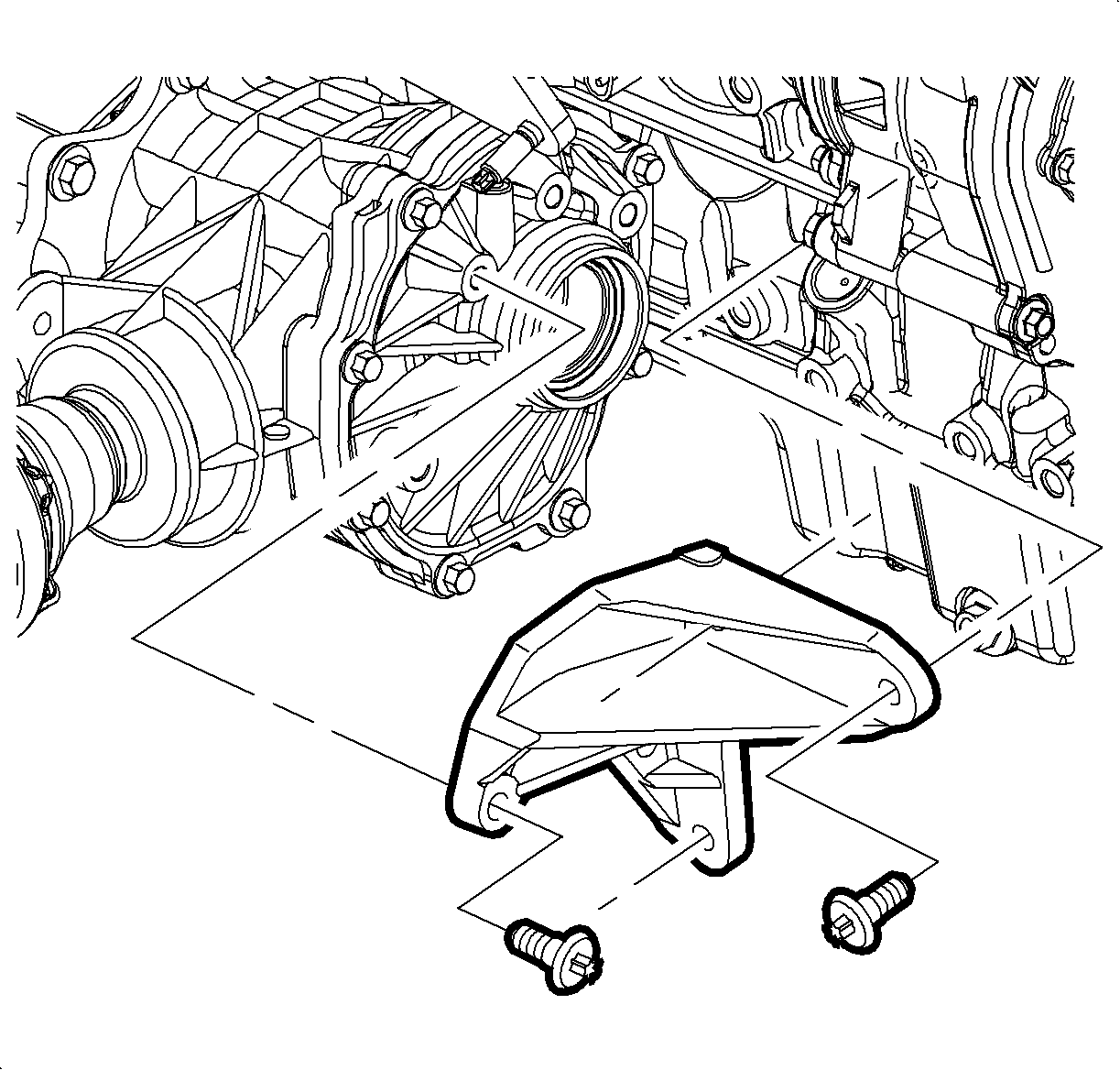
- If equipped with AWD, remove the transfer case mounting bracket bolts and bracket.
- If equipped with front wheel drive (FWD), remove the intermediate shaft. Refer to
Intermediate Shaft Replacement.
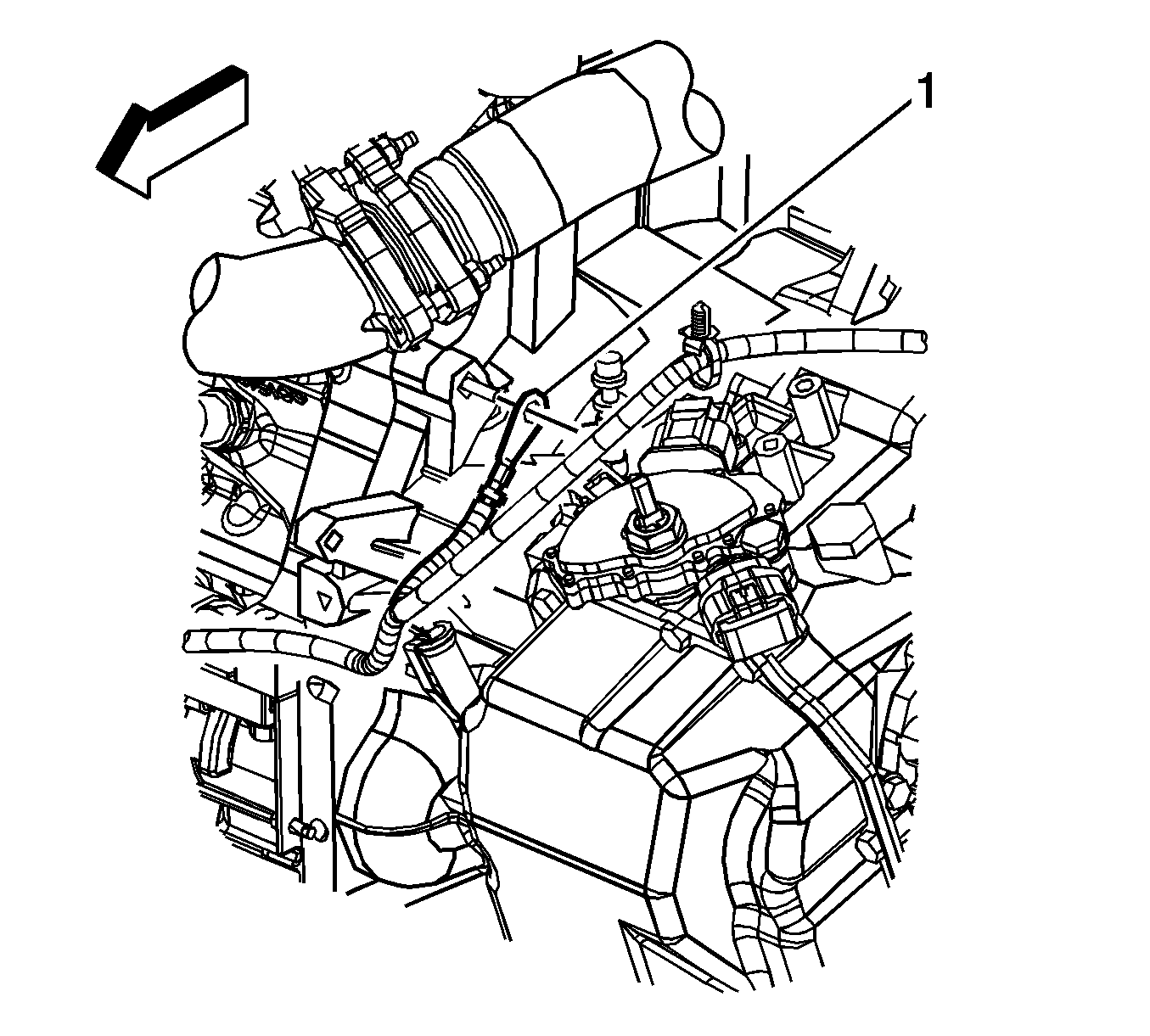
- Remove the negative battery cable-to-transaxle nut from the transaxle stud.
- Remove the negative battery cable (1) from the transaxle stud.

- Remove the engine-to-transaxle brace bolts (1, 2) and brace (3).
- Remove the starter motor. Refer to
Starter Replacement.
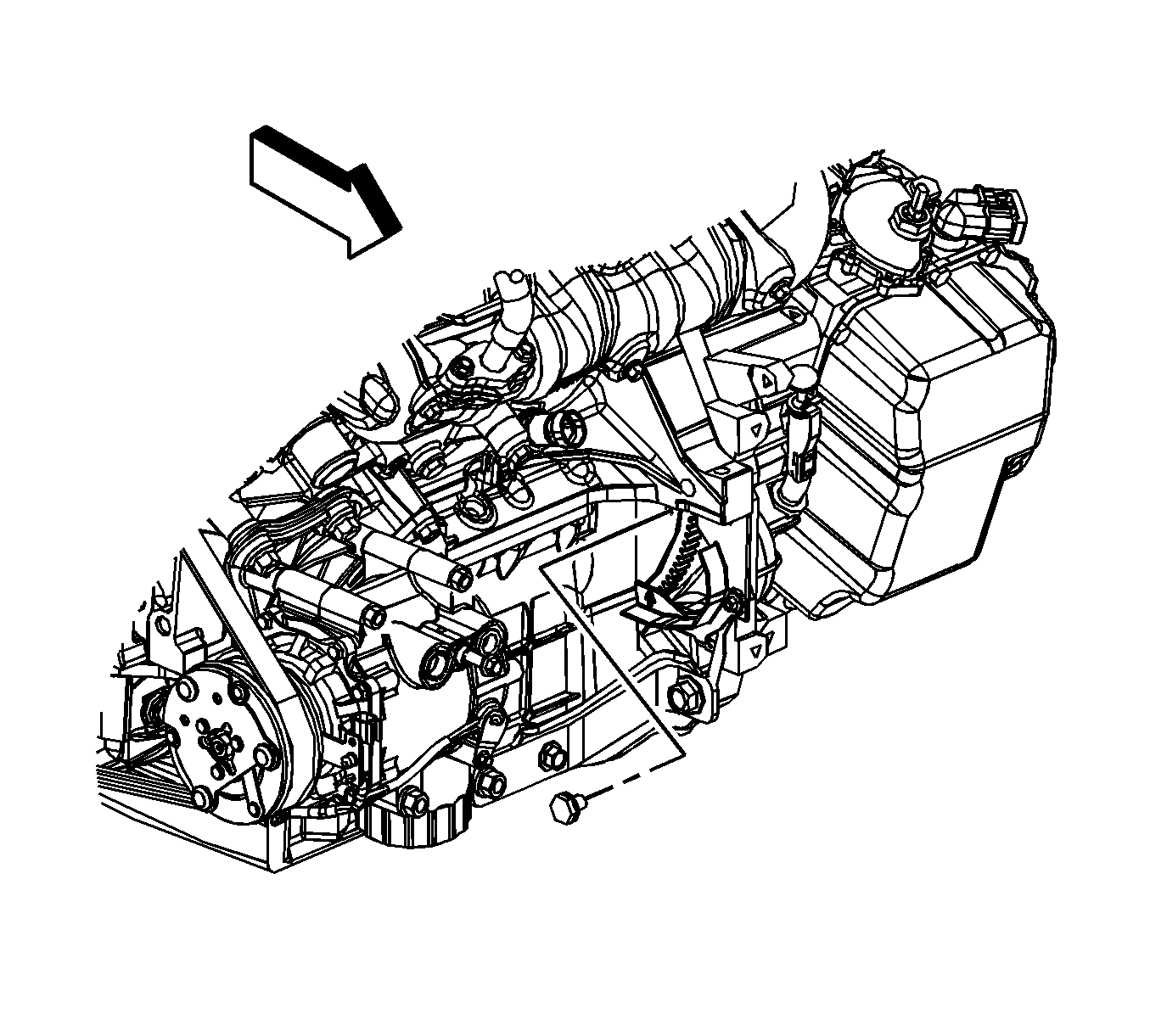
- Remove the torque converter bolts.
- Install an engine lift chain to the engine lift brackets.
- Support the engine weight with an engine hoist.
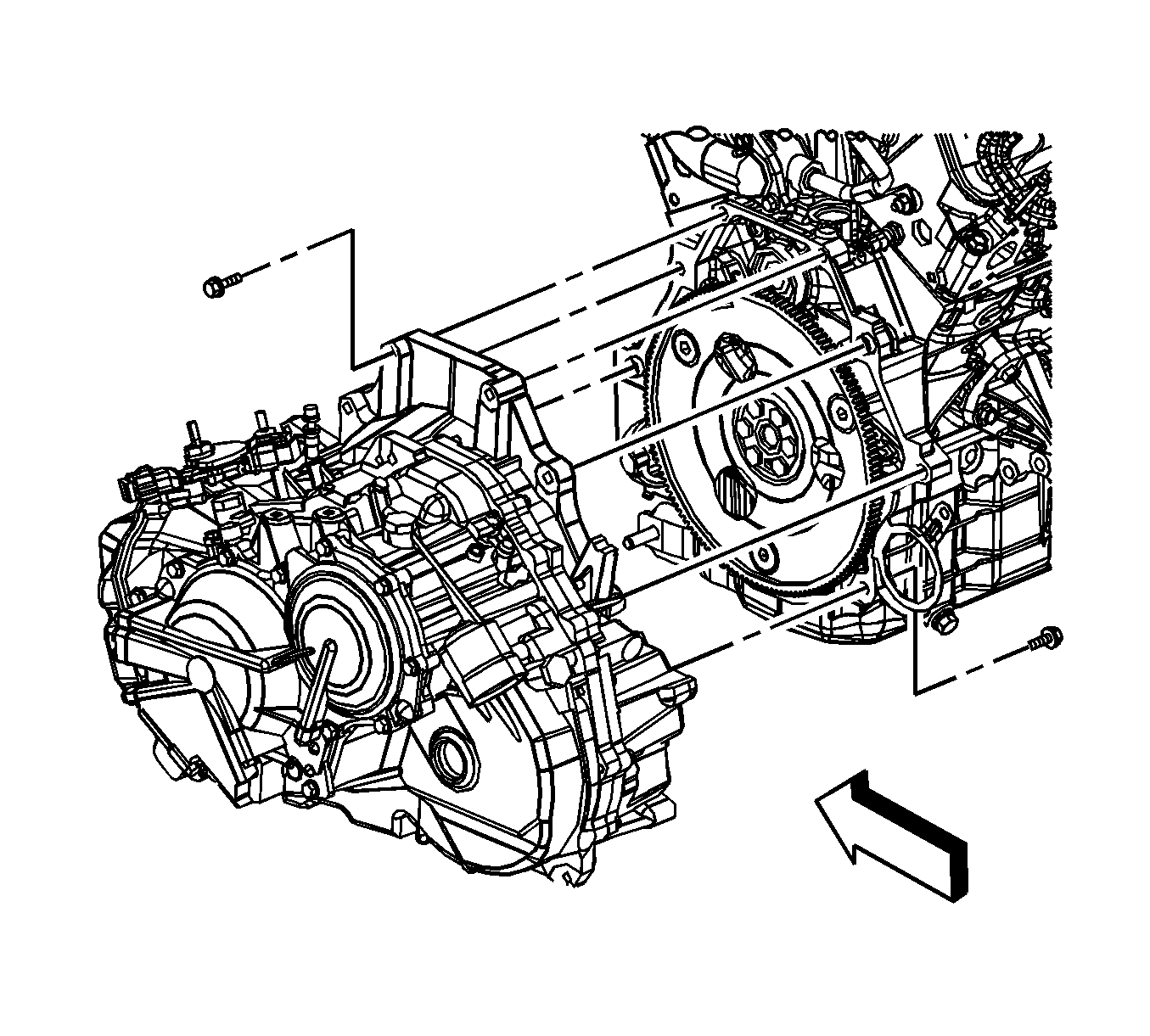
- Remove the automatic transaxle bolts.
- Separate the automatic transaxle from the engine.
- Lift the engine away from the frame and the automatic transaxle.
- Secure the engine to an engine stand.
- Remove any additional engine components as necessary. Refer to appropriate component sections in manual if needed.
Installation Procedure
- Remove the engine from the engine stand.

- Align the engine to the frame and automatic transaxle.
Caution: Refer to Fastener Caution in the Preface section.
- Install the automatic transaxle bolts and tighten to
75 N·m (55 lb ft).
- Place a block of wood between the frame and the engine oil pan in order to support the engine on the frame once the engine hoist is removed.

- Install the torque converter bolts and tighten to
60 N·m (44 lb ft).
- Install the starter motor. Refer to
Starter Replacement.
- Remove the engine hoist and lift chain.

- Install the engine to transaxle brace (3) and bolts (1, 2) and tighten the bolts to
50 N·m (37 lb ft).

- Install the negative battery cable (1) to the transaxle stud.
- Install the negative battery cable-to-transaxle nut to the transaxle stud and tighten the nut to
45 N·m (33 lb ft).

- If equipped with AWD, install the transfer case mounting bracket and bolts and tighten the bolts to
60 N·m (44 lb ft).
- If equipped with FWD, install the intermediate shaft. Refer to
Intermediate Shaft Replacement.

- Install the fuel pipe retainer to the threaded stud on the transaxle.
- Install the nut securing the fuel pipe to the transaxle and tighten to
28 N·m (21 lb ft).
- Install the throttle body assembly. Refer to
Throttle Body Assembly Replacement.

- Connect the engine electrical wiring harness to the following components:
| • | Oil pressure indicator switch (2) |

- Connect the engine electrical wiring harness to the following components:
| • | Install wire harness to retainer (3) |
| • | AC refrigerant pressure sensor (2) |
| • | Air conditioning (AC) compressor clutch (1) |

- If equipped with an engine coolant heater, connect the coolant heater cord.

- Connect the engine electrical wiring harness to the following components:
| • | Install the wire harness to retainers (5, 6). |
| • | Install ground lead (3) and bolt (4). |
| | Tighten the bolt to
25 N·m (18 lb ft). |

- Connect the engine electrical wiring harness to the following components:
| • | Install wire harness to retainers (8, 11, 13) |
| • | Ignition coil/control module (12) |
| • | Fuel injector inline connector (7) |
| • | Generator regulator (6) |
| • | Install generator B+ lead (2) and nut (1) |
| | Tighten the nut to
13 N·m (115 lb in). |
| • | EVAP purge solenoid (5) |
Note: Inspect for areas of body to powertrain contact or entanglement of wires and hoses while joining the vehicle body to the powertrain.
- Carefully lower the vehicle body down to the powertrain.

- Install NEW frame-to-body bolts and tighten to
155 N·m (114 lb ft).
- Raise the vehicle up away from the frame support fixture or jackstands and remove the support fixture or jackstands from under the vehicle.
- Lower the vehicle.

- Install the bolts that secure the left transaxle mount to the transaxle and tighten the bolts to
50 N·m
(37 lb ft).

- Install the bolts (2) that secure the right engine mount (1) to the engine (3) and tighten
the bolts to
50 N·m (37 lb ft).
- Raise the vehicle.

- Remove the block of wood (1) between the frame and the transaxle used to
support the transaxle while the bolts were removed from the left transaxle mount.

- Remove the block of wood (1) between the frame and the engine oil pan used to support the engine while
the bolts were removed from the right engine mount.
- If equipped with AWD, install the rear propeller shaft. Refer to
Propeller Shaft Replacement.
- Install the right and left front wheel drive shafts. Refer to
Front Wheel Drive Shaft Replacement.

- Install the right and left lower ball joints to the steering knuckles. Refer to
Lower Control Arm Replacement.

- Install the right and left stabilizer shaft links to the stabilizer shaft. Refer to
Stabilizer Shaft Link Replacement.

- Install the right and left tie rod ends to the steering knuckles. Refer to
Steering Linkage Outer Tie Rod Replacement.

- Connect the steering intermediate shaft to the steering gear.
- Install a NEW pinch bolt to the steering intermediate shaft and tighten the bolt to
34 N·m (25 lb ft).
- Install the right and left engine splash shields. Refer to
Engine Splash Shield Replacement.
- Install the front tires. Refer to
Tire and Wheel Removal and Installation.

- If equipped with AWD, connect the transfer case vent hose to the transfer case.
- Install the catalytic converter. Refer to
Catalytic Converter Replacement.

- Install the HO2S 2 wiring harness retainers (1, 3) to the vehicle underbody.
- Connect the HO2S 2 wiring harness.
- Install the front bumper fascia air deflector. Refer to
Front Bumper Fascia Air Deflector Replacement.

- Install new seals and connect the transaxle oil cooler lines to the transaxle. Refer to
Transmission Fluid Cooler Pipe Seal Replacement.
- Install the radiator outlet hose. Refer to
Radiator Outlet Hose Replacement.
- Lower the vehicle.
- Install the radiator inlet hose. Refer to
Radiator Inlet Hose Replacement.
- Connect the heater hoses to the engine. Refer to
Heater Inlet Hose Replacement and
Heater Outlet Hose Replacement.
- Install the coolant surge tank. Refer to
Radiator Surge Tank Replacement.
- Untie the radiator, AC condenser, and fan module assembly from the upper radiator support.

- Connect engine to body inline connector C102 (2).
- Connect the transaxle shift control cable to the transaxle. Refer to
Shift Control Cable Replacement.
- Install the AC compressor hose assembly to the compressor. Refer to
Air Conditioning Compressor Hose Replacement.

- Connect the engine fuel hose/pipe (3) to the chassis fuel hose/pipe (2). Refer to
Metal Collar Quick Connect Fitting Service.
- Connect the EVAP hose/pipe to the EVAP canister purge solenoid valve. Refer to
Plastic Collar Quick Connect Fitting Service.
- Install the air cleaner assembly and air intake duct. Refer to
Air Cleaner Assembly Replacement.

- Install the TCM (1) to the TCM bracket (2).

- Connect the brake booster vacuum hose (2) to the intake manifold.
- Position the clamp (1) on the brake booster vacuum hose connection.
- Install the fuel injector sight shield. Refer to
Fuel Injector Sight Shield Replacement.

- Install the negative battery cable from the inner fender body ground stud.
- Install the negative battery cable nut (2) to the inner fender body ground stud and tighten the nut to
12 N·m (106 lb in).

- Install the battery cable retainers (1) to the battery tray.
- Install the battery box, battery and ECM. Refer to
Battery Box Replacement.
- Fill the engine with engine oil. Refer to
Approximate Fluid Capacities ,
Fluid and Lubricant Recommendations , and
Maintenance Schedule.
- Fill the engine with coolant. Refer to
Cooling System Draining and Filling.
- Check the transaxle fluid level. Refer to
Adhesives, Fluids, Lubricants, and Sealers ,
Transmission General Specifications , and
Fluid Capacity Specifications.
- Charge the AC system. Refer to
Refrigerant Recovery and Recharging.
- Prime the fuel system.
| 69.1. | Cycle the ignition ON for 5 seconds then OFF for 10 seconds. Repeat cycling twice. |
| 69.2. | Crank the engine until it starts. The maximum starter motor cranking time is 20 seconds. |
| 69.3. | If the engine does not start, repeat the steps. |
- Perform the CKP system variation learn procedure. Refer to
Crankshaft Position System Variation Learn.


























































